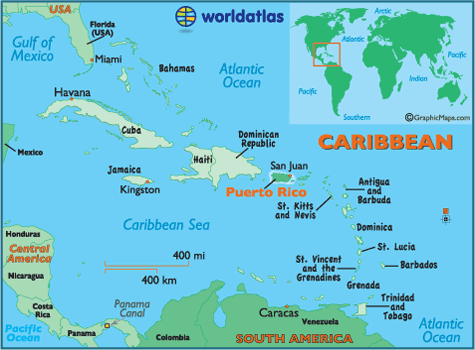Puerto Rico
THE ESTADO LIBRE Asociado de Puerto Rico is a densely populated island in the eastern Greater Antilles in the CARIBBEAN SEA, divided into 78 counties. Even though it is a possession of the UNITED STATES, Puerto Rico is an independent commonwealth and has selfgovernance in all its local affairs. The rectangularshaped, mostly mountainous volcanic island is approximately 100 mi (160 km) east to west and 35 mi (56 km), north to south and has a total land area of 3,515 square mi (9,103 square km). Four other satellite islands—Mona, Desecheo, Culebra, and Vieques—are also under its control. Puerto Rico's warm and humid tropical weather varies little throughout the year and is often interrupted by hurricane season from June to November. San Juan, its largest and oldest city, is also its capital. Other large cities include Ponce, Mayaguez, and Caguas. The 2014 estimated population was 3.548 million.

Boriquen was the name given for Puerto Rico by its primary inhabitants, the Taino, at the time Christopher Columbus discovered the island in 1493. The Spanish, in search of gold and resources, eventually wiped out the natives by disease, war, and slavery. In 1511, Puerto Rico became the first Spanish colony in the New World and was attacked periodically by the British and Dutch. Many African slaves later arrived to work on the sugar plantations. The island remained in Spanish hands until after the Spanish American War, when it became part of the United States. Today, there is an ongoing debate between gaining complete independence, keeping its commonwealth status, or becoming the 51st state.
Puerto Rico has a very distinctive and mixed culture, influenced by its Taino, Spanish, African, and American heritages. Approximately 80 percent of the population is white, 8 percent African, and 12 percent mixed or other ethnicities. Both Spanish and English are spoken, and the majority of the population is Roman Catholic.
The island's varied topography can be divided into four main regions. Much of the interior of the island is covered by the Cordillera Central, the central mountain range, which contains the island's highest point, Cerro de Punta at 4,390 ft (1,338 m), and El Yunque rainforest, also known as Caribbean National Forest. On the north part of the island is an area of foothills called the Karst Country, made up of beautiful limestone rock formations and underground rivers. On the southwest corner of Puerto Rico is a region of coastal dry forest, made up of desert trees, cacti, bedrock, and many migratory birds, that is environmentally different from other moister parts of the island.
The fourth geographical zone is the narrow coastal plain around the perimeter of Puerto Rico, which includes beautiful sunny beaches, bioluminescent bays, and cities that help make Puerto Rico a popular tourist destination. There are 45 nonnavigable rivers in total in Puerto Rico which flow into the coastal plain, the longest being Rio Grande de Loiza. Puerto Rico has no natural lakes and 12 artificial reservoirs. Common environmental concerns include population growth, urbanization, deforestation, water pollution, and soil erosion.
Puerto Rico's diverse economy is almost equally divided in terms of gross domestic product (GDP) by manufacturing, especially chemical and pharmaceutical production, and service industries, including tourism. Agriculture contributes 2 percent of the nation's GDP, and tourism 6 percent. The island's primary natural resources are clay, limestone, salt, sand, gravel, stone, copper, nickel, and petroleum.